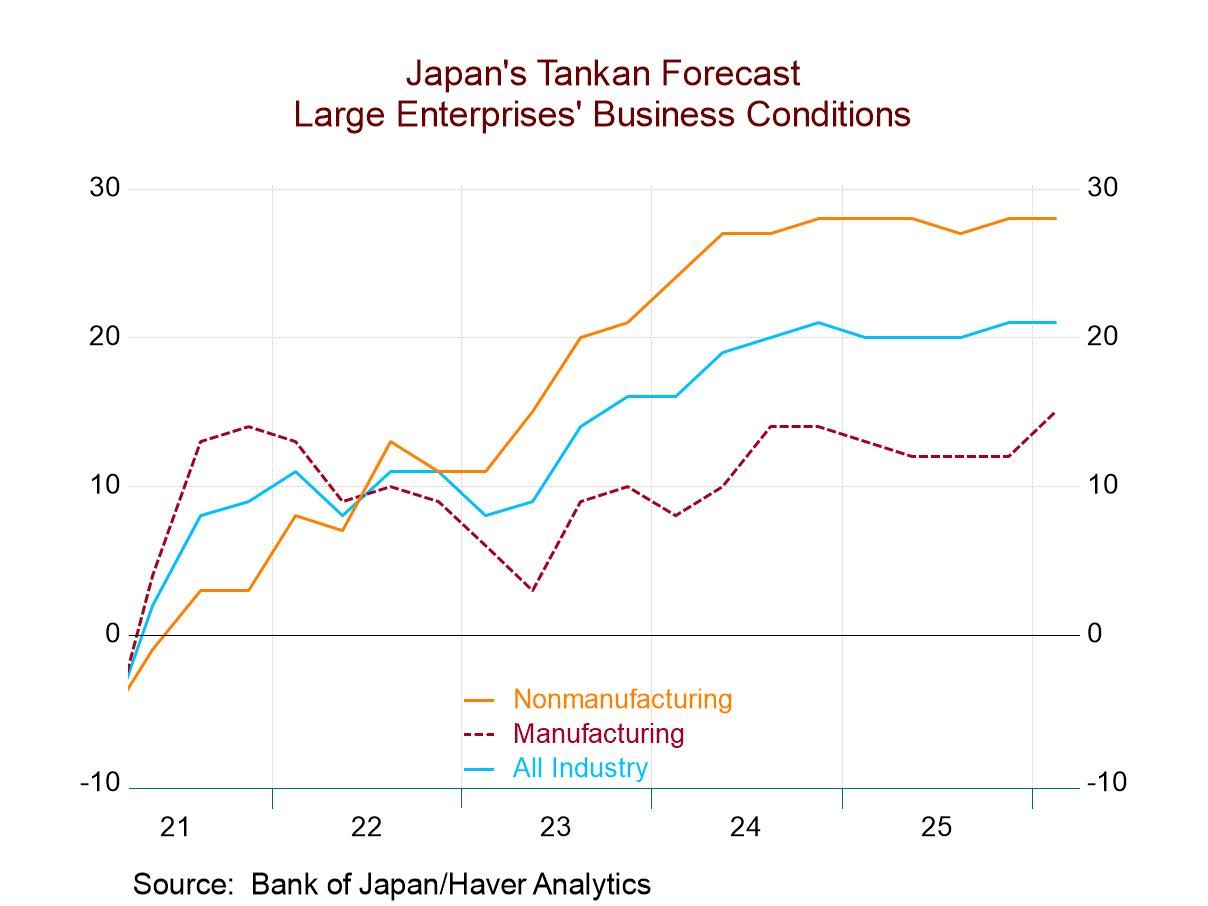U.S. Q4 GDP Growth Revised Down Slightly in Third Estimate
by:Sandy Batten
|in:Economy in Brief
Summary
- Inventories made even larger contribution than in first two estimates.
- Domestic demand growth revised down. Corporate profit growth slowed.
- Price inflation unrevised at 40-year high.


U.S. real GDP growth in 2021 Q4 was revised down to 6.9% q/q (SAAR) in the third estimate from 7.0% in the second estimate. The Action Economics Forecast Survey had expected a small upward revision to 7.1%. Real GDP growth for all of 2021 was unrevised at 5.7%, the fastest annual pace since 1984.
This report contained the first look at the performance of corporate profits in 2021 Q4. Corporate profits with inventory valuation and capital consumption adjustments rose a modest 0.7% q/q not annualized (+21.0% y/y) after a 3.4% q/q gain in Q3. Profits of domestic industries edged up 0.2% q/q while profits from the rest of the world rose 3.3% q/q.
Inventory rebuilding added more to overall real GDP growth in the third estimate than in either of the first two. Inventories rose $22 billion (chained 2012 at an annual rate) more in the third estimate than they had in the second. This boosted their contribution to overall GDP growth to 5.32%-points from 4.90%-points in the second estimate. This large a contribution from inventory building would normally augur a sharp slowdown in the next quarter. However, inventory depletion had previously been so large, that further rebuilding is likely going forward. However, the likely continued rebuilding will probably take place at a slower rate and so, inventory building expected over the next few quarters will likely be a modest drag on overall GDP growth.
Growth in demand was revised slightly weaker in the third estimate with final sales growth revised down to 1.5% q/q (SAAR) from 2.0% and domestic final sales growth revised down to 1.7% from 2.0%. A downward revision to personal consumption expenditures growth accounted for much of the downward revision to overall demand. PCE growth was revised down to 2.5% q/q from 3.1% in the second estimate and 3.3% in the advance estimate. Today's revision reflected downward revisions to spending on both goods and services.


Nonresidential business investment spending growth was revised down to 2.1% q/q from 3.1% but residential investment spending growth was upped to 2.1% from 1.0%. The 2.6% quarterly decline in spending by governments was not revised. Export growth was revised down slightly while import growth was revised up slightly, resulting in net exports subtracting slightly more from overall growth than in the second estimate (-0.23%-pt vs. -0.07%-pt in the second estimate).
Overall inflation in Q4 was unrevised but continued to run hot. The GDP price index increased 7.1% q/q (SAAR), the same as in the second estimate but still the fastest rate since 1981 Q3. No revision had been expected. The PCE price index was revised up slightly to a 6.4% increase from 6.3%. By contrast, prices of residential investment rose a downwardly revised 11.9% vs. 12.1% in the second estimate, but this was still their fourth consecutive quarterly double-digit increase.
The GDP figures can be found in Haver's USECON and USNA databases. USNA contains virtually all of the Bureau of Economic Analysis' detail in the national accounts. Both databases include tables of the newly published not seasonally adjusted data. The Action Economics consensus estimates can be found in AS1REPNA.


Sandy Batten
AuthorMore in Author Profile »Sandy Batten has more than 30 years of experience analyzing industrial economies and financial markets and a wide range of experience across the financial services sector, government, and academia. Before joining Haver Analytics, Sandy was a Vice President and Senior Economist at Citibank; Senior Credit Market Analyst at CDC Investment Management, Managing Director at Bear Stearns, and Executive Director at JPMorgan. In 2008, Sandy was named the most accurate US forecaster by the National Association for Business Economics. He is a member of the New York Forecasters Club, NABE, and the American Economic Association. Prior to his time in the financial services sector, Sandy was a Research Officer at the Federal Reserve Bank of St. Louis, Senior Staff Economist on the President’s Council of Economic Advisors, Deputy Assistant Secretary for Economic Policy at the US Treasury, and Economist at the International Monetary Fund. Sandy has taught economics at St. Louis University, Denison University, and Muskingun College. He has published numerous peer-reviewed articles in a wide range of academic publications. He has a B.A. in economics from the University of Richmond and a M.A. and Ph.D. in economics from The Ohio State University.






 Asia
Asia